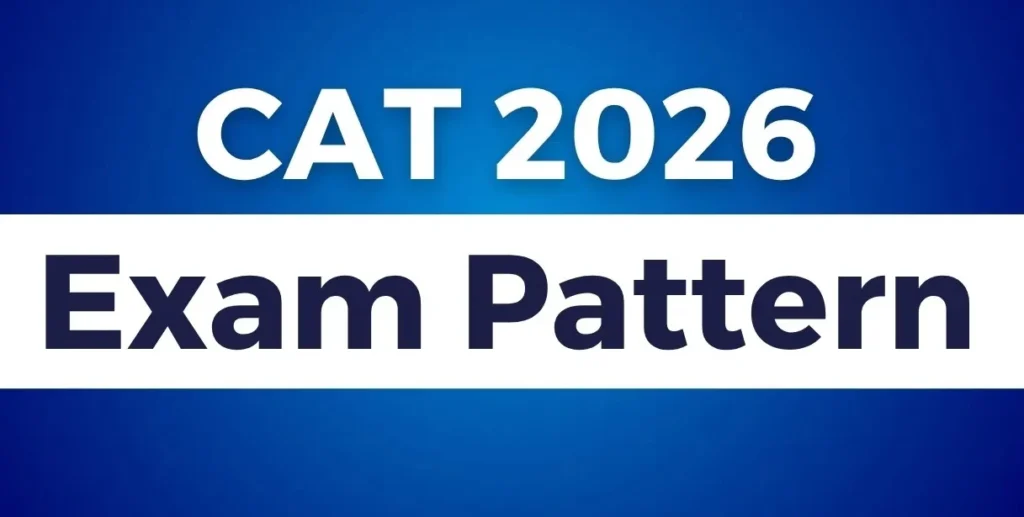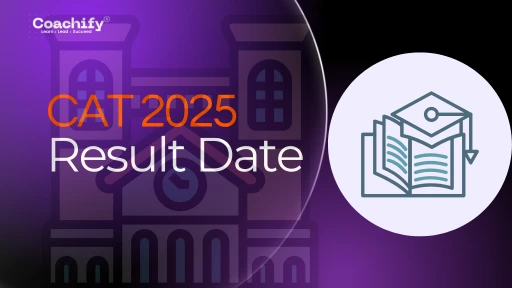Understanding the CAT exam pattern 2026 is the first step toward a successful IIM admission strategy. With changes in question types, TITA distribution, and sectional structure, knowing what to expect in CAT 2026 can significantly impact your preparation. This guide covers the updated CAT exam pattern, marking scheme, total questions, and strategic insights to help aspirants navigate the exam with confidence.

Table of Contents
CAT Exam Pattern 2026: Full Breakdown
The CAT exam pattern features three sections—VARC, DILR, QA—each with 40 minutes. Expect around 66 total questions, with both MCQs and TITA (non-MCQ) items.
| Section |
Total Qs |
MCQ |
TITA |
Time |
| VARC |
~24 |
~15 |
~9 |
40m |
| DILR |
~20 |
~12 |
~8 |
40m |
| QA |
~22 |
~14 |
~8 |
40m |
| Total |
~66 |
~41 |
~25 |
120m |
This CAT exam pattern balances reasoning, comprehension, and math under pressure.
- Total Questions: 66
- Duration: 120 minutes
- Mode: Computer-Based (CBT)
Also read: CAT Notification 2025 – Official Exam Date, Registration & PDF Update
CAT 2026 Section-Wise Breakdown
The CAT exam pattern 2026 continues the tri-section format, testing aspirants on their comprehension, reasoning, and quantitative skills. Here's a deeper dive into what to expect in each section:
VARC – Verbal Ability & Reading Comprehension
- Reading Comprehension (RC):
- 4 passages
- Approximately 16 questions
- Mix of fact-based and inference-driven RCs from topics like philosophy, history, economics, and environment.
- Verbal Ability (VA):
- Around 8 questions
- Includes Para Jumbles, Para Summary, and Odd Sentence Out
- No grammar or vocabulary-based direct questions
The CAT exam pattern has clearly shifted away from grammar-heavy questions toward comprehension and logic within language. Building a daily reading habit using sources like The Economist, LiveMint, and Aeon Essays is vital.
Also read: How to Crack CAT in 6 Months: Ultimate CAT 2025 Preparation Guide
DILR – Data Interpretation & Logical Reasoning
- Expected Number of Sets: 4
- Questions per Set: Around 5
- Total DILR Questions: 20 (approx.)
- Set Types Include:
- Graph Interpretation (Bar, Line, Pie)
- Venn Diagrams & Set Theory
- Logical Games (Sudoku-style puzzles, matrix arrangements)
- Caselets with business scenarios
The CAT exam pattern has increasingly focused on set-based reasoning, which requires candidates to interpret, analyze, and act on data under time pressure.
Practice high-level puzzles and previous year CAT DILR sets regularly. Also, focus on accuracy under pressure.
QA – Quantitative Aptitude
The Quantitative Aptitude section of the CAT exam pattern continues to be dominated by Arithmetic and Algebra, making up nearly 70% of the total QA questions. It's not just about formulas—it’s about speed, strategy, and smart solving.
Topic-Wise Breakdown:
- Arithmetic (~9 Questions)
- Topics: Percentages, Averages, Time-Speed-Distance, Time & Work, Profit & Loss
- Focus: Concept clarity, application-based practice
- Algebra (~6 Questions)
- Topics: Linear & Quadratic Equations, Inequalities, Modulus, Functions
- Focus: Equation solving tricks and substitution-based methods
- Geometry & Mensuration
- Angles, Triangles, Circles, Areas, Volumes – appear moderately but can be scoring with visualization techniques
- Number Systems
- Important for base conversions, remainders, divisibility, and LCM-HCF problems
- Modern Math
- Permutations & Combinations, Probability, Set Theory
- These questions are less frequent but often tricky—best prepared with concept-based examples
Speed + Accuracy = CAT Success
In the new CAT exam pattern, solving fast matters as much as solving right. This is where Coachify’s Calculation Techniques Module comes into play.
What you’ll learn in Coachify’s Quant Calculation Course:
- Vedic Math shortcuts
- Rapid multiplication & division
- Percentage-to-fraction tricks
- Square roots & cube roots in seconds
Whether it's a complex QA question or DI table-based calculation, these techniques can save up to 5–7 valuable minutes in the exam.
Access Now: Master CAT Calculation Techniques – Pre-recorded Module
Formula retention, conceptual clarity, and speed practice are critical. Use quant-focused test series and CAT books like Arun Sharma and Nishit Sinha.
CAT 2026 Marking Scheme (MCQ vs TITA)
Understanding the CAT exam pattern means understanding the marking strategy:
| Question Type |
Correct |
Incorrect |
Unattempted |
| MCQ |
+3 |
-1 |
0 |
| TITA (Non-MCQ) |
+3 |
0 |
0 |
- MCQs come with negative marking
- TITA (Type In The Answer) questions allow guesses without penalty
Explore: CAT Score vs Percentile 2025 – Full Comparison
Slot-wise Strategy for CAT 2026
The CAT exam pattern remains constant across all three slots — Morning, Afternoon, and Evening — but the difficulty level may vary slightly. Since CAT scores are scaled and normalized, your raw score might not directly translate to percentile.
Strategy Tips:
- Give mocks in your preferred slot (as likely assigned based on past experience or registration)
- Track historical slot-wise performance trends
- Don’t panic if a section feels unusually tough — normalization will adjust it
- Aim for consistency across mocks rather than one-off high scores
Must-read: CAT 2025 Coaching vs Self Study – What Do Toppers Recommend?
How the CAT Exam Pattern Affects Your Preparation
With every shift in the CAT exam pattern, aspirants must adapt their strategies. Recent trends show:
VARC:
- Less vocabulary and grammar, more logical comprehension
- RCs dominate; focus on critical reading and inference
DILR:
- Traditional logic questions replaced with complex, data-heavy sets
- Visual reasoning and interpretation critical
QA:
- Arithmetic is the backbone of Quant
- Conceptual depth in Algebra and Numbers needed
- Geometry questions are often moderate to difficult
Coachify recommends a section-wise approach:
- VARC: Develop reading stamina + focus on theme identification
- DILR: Solve puzzles every day from CAT-level resources
- QA: Maintain a formula sheet + give topic-wise quizzes weekly
Tip: Adapt your prep plan to include realistic mocks, exam simulations, and full-length tests in actual time slots.
Best Books & Mock Test Strategy for CAT Exam Pattern 2026
Top Books (Section-Wise)
- Quant: Arun Sharma, Nishit Sinha
- DILR: Puzzle Book, Arun Sharma
- VARC: RC99 by IMS, Norman Lewis
Mock Test Strategy
Align your CAT prep with the exam pattern by:
- Completing 15–20 full-length mocks
- Daily sectional drills using Coachify test series
- Review performance per mock and adapt strategies
Download Free CAT Mocks from Coachify: Telegram Group
Coaching vs Self-Study: Which Works Best?
Choose Coachify if you want:
- Doubt-solving support
- Structured videos + notes
- Personalized mentorship
- Daily schedule + mock strategy
Join now:
Self-study works best for:
- Repeaters
- Students with strong Quant/English base
- Those who already gave 1–2 CAT attempts
Also read: Best CAT Coaching for 2025 – How to Choose
CAT TITA Distribution: What to Expect
In 2026, the expected TITA question distribution is:
- VARC: 4 TITA
- DILR: 2–3 TITA
- QA: 6–7 TITA
Why TITA matters?
- No negative marking = safe attempts
- Usually harder than MCQs
- Ideal for confident guessers
Conclusion
The CAT exam pattern 2026 may not look drastically different from CAT 2025, but every minor change impacts strategy. From marking scheme tweaks to TITA ratio, you need a preparation plan that adapts to the latest format.
Coachify's expert mentors, mocks, and content will help you decode the pattern and target IIM success. Whether you’re targeting IIM Ahmedabad or newer IIMs like Kashipur or Udaipur, mastering the CAT exam pattern is the first step.
 Kiboo
Kiboo








